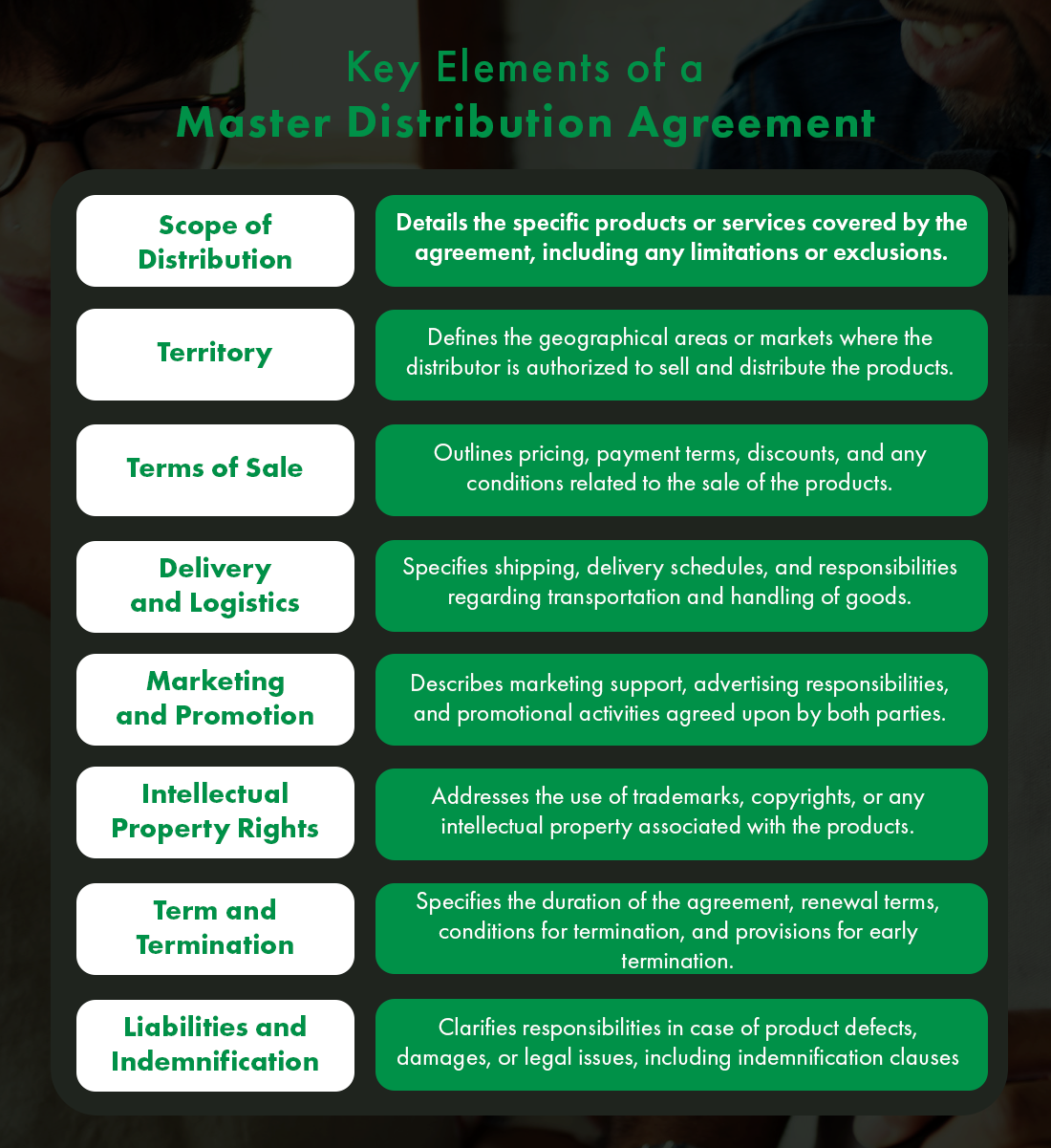A Consolidated Guide to Foodservice Master Distribution Agreements
When overseeing multiple locations, understanding the intricacies of Master Distribution Agreements (MDAs) becomes essential in navigating the complex landscape of the foodservice industry. This blog serves as a compass, illuminating the vital components and nuances of these agreements.
What is a Master Distribution Agreement?
A master distribution agreement (MDA) is a comprehensive contract between a manufacturer or supplier and a distributor that governs the terms and conditions of their relationship regarding the distribution of products. This agreement outlines the rights, responsibilities, and obligations of both parties involved in the distribution process.

MDAs provide a structured framework for the distribution relationship, minimizing misunderstandings and conflicts between manufacturers and distributors. They offer a roadmap for how products will be sold, delivered, and marketed, ensuring a consistent and mutually beneficial partnership.
How is an MDA related to the supply chain?
An MDA (Master Distribution Agreement) plays a significant role within the supply chain, especially in scenarios where manufacturers or suppliers rely on distribution partners to reach their end customers. Here’s how an MDA intersects with the supply chain:
- Streamlining Distribution: An MDA outlines the terms and conditions for the distribution of products, specifying how goods move from the manufacturer to the end consumer through intermediaries, enhancing supply chain efficiency.
- Inventory Management: The agreement addresses inventory levels, replenishment schedules, and responsibilities, influencing efficient inventory management within the supply chain.
- Logistics and Transportation: The MDA defines delivery terms and logistics responsibilities, impacting the logistical flow within the supply chain.
- Quality Control: It sets expectations for product quality and consistency, ensuring that the supply chain maintains these standards throughout the distribution process.
- Risk Mitigation: MDAs often include clauses addressing risk allocation and liability, establishing procedures for mitigating risks within the supply chain.
How does a Master Distribution Agreement work?
A Master Distribution Agreement (MDA) delineates the terms and conditions governing the relationship between a manufacturer or supplier and a distributor. Here’s how it typically works:
- Negotiation and Drafting: The process starts with negotiations between the manufacturer and the distributor, discussing various aspects of the agreement, including scope, pricing, territories, marketing support, etc.
- Execution and Implementation: Once finalized and signed, the distributor gains the right to sell and distribute the products according to the agreement.
- Distribution Process: The distributor procures the products from the manufacturer and distributes them to various retailers, wholesalers, or end customers as per the agreement, handling logistics, marketing, and sales activities.
- Compliance and Performance: Both parties are expected to comply with the terms of the MDA, ensuring product quality, fulfilling orders, meeting sales targets, and maintaining marketing commitments.
- Monitoring and Amendments: Throughout the agreement, both parties monitor compliance and performance, potentially renegotiating or amending the MDA to accommodate changes affecting the distribution relationship.
- Termination or Renewal: The MDA specifies the duration of the agreement and conditions for termination or renewal.
MDAs are crucial in defining the distribution relationship, ensuring clarity, and protecting the interests of both the manufacturer and the distributor.
What are common areas of a master distribution agreement?
The sections within a Master Distribution Agreement (MDA) typically cover various aspects of the relationship between the manufacturer or supplier and the distributor. Here are 10 common sections found in an MDA:
- Introduction and Definitions: Basic details and clarification of terms used.
- Appointment and Scope: Defines what the distributor is responsible for, including products, territories, and rights.
- Terms, Termination, and Renewal: Duration, conditions for ending or extending the agreement.
- Distribution Obligations: Responsibilities for marketing, sales, and reporting.
- Pricing, Payments, and Orders: Details pricing, discounts, payment terms, and ordering procedures.
- Product Delivery and Quality Control: Covers shipping, delivery, quality standards, and inspection processes.
- Intellectual Property and Rights: Ownership, usage, and protection of trademarks or patents.
- Warranties, Liabilities, and Indemnities: Guarantees, limitations of liability, and responsibility for product issues.
- Confidentiality and Non-Disclosure: Protects sensitive information shared between parties.
- Governing Law and Disputes: Specifies the law governing the agreement and procedures for resolving disagreements.
Why should restaurant operators pay attention to their MDA?
Multi-unit restaurant operators should focus on their Master Distribution Agreement for several crucial reasons:
- Consistency Across Locations: MDAs establish standards for product quality and supply chain management, ensuring consistent customer experiences across multiple units.
- Economies of Scale: Operators benefit from volume-based discounts and negotiated pricing, leveraging these economies of scale effectively across their network.
- Supply Chain Efficiency: Clear terms dictate logistics, delivery schedules, and inventory management, ensuring efficient operations without disruptions.
- Risk Mitigation: MDAs outline liabilities, warranties, and dispute resolution mechanisms, helping operators manage risks effectively.
- Operational Streamlining: Clarity on MDA terms facilitates efficient procurement, inventory management, and distribution strategies.
- Relationship with Distributors: Understanding terms fosters a collaborative partnership with distributors, aligning expectations and responsibilities.
- Compliance Monitoring: Adherence to MDA terms allows for consistent compliance and timely interventions if deviations occur.
- Negotiation Power: Knowledge of the MDA’s impact on operations gives operators better leverage in negotiations for renewals or modifications.
Each MDA significantly influences the efficiency, cost-effectiveness, and uniformity of operations across a restaurant network, warranting close attention.
How do operators get the most out of their Master Distribution Agreement?
Getting the most out of a Master Distribution Agreement involves several key strategies, and partnering with experts can significantly enhance these efforts:
- Leveraging Expertise: Partnering with specialized service providers Consolidated Concepts aids in negotiating and optimizing purchasing strategies within the MDA terms.
- Maximizing Cost Savings: Experts leverage purchasing power for competitive pricing and volume-based discounts, optimizing costs.
- Tailored Solutions: Tailoring MDA terms to align with unique requirements ensures maximum benefits across all units.
- Streamlined Operations: Comprehensive solutions from Consolidated Concepts assist with logistics, inventory management, and supply chain optimization.
- Data-Driven Insights: Analyzing data helps make informed decisions for refining strategies and maximizing MDA benefits.
- Partnership for Growth: Strategic partners contribute to the growth and profitability of the restaurant network.
- Continuous Support: Ongoing support assists in monitoring compliance, addressing challenges, and optimizing the agreement.
Partnering with Consolidated Concepts enables operators to unlock the full potential of their MDAs, driving growth, operational efficiency, and profitability across their restaurant business.





































